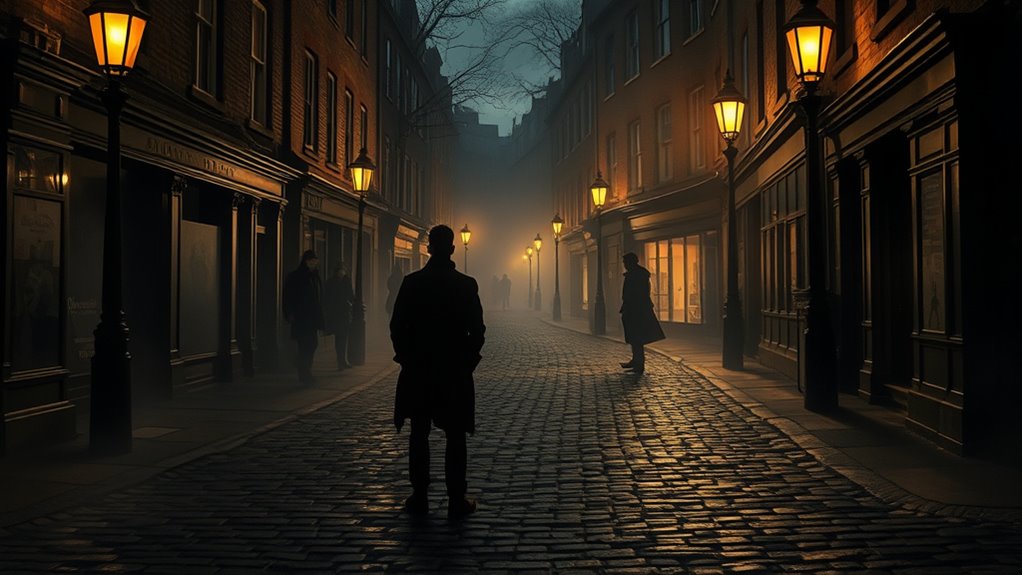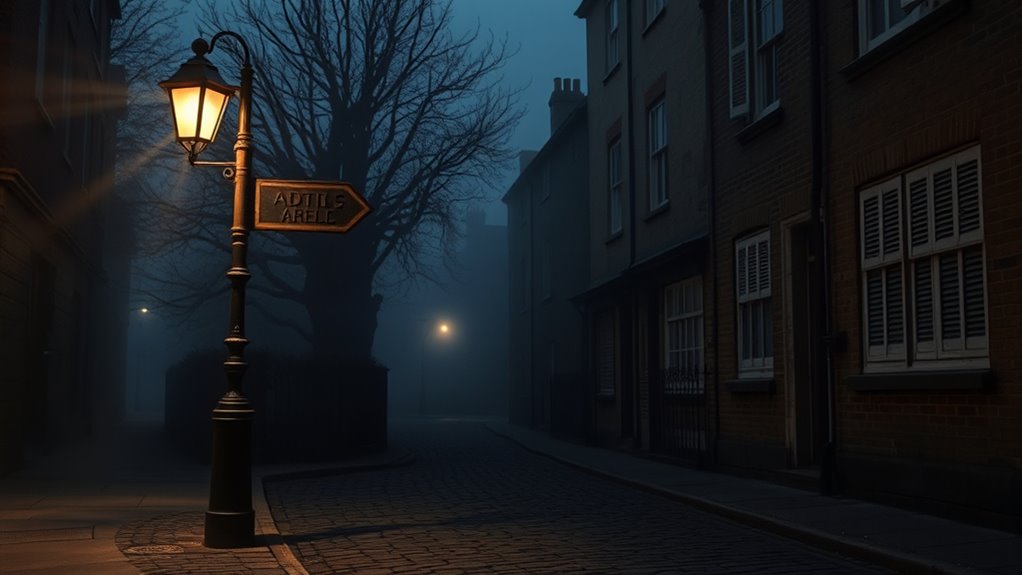In 1804, fear and superstition in Hammersmith led residents to believe they saw a ghost, causing panic and increased armed vigilance. When Francis Smith saw a shadowy figure, he thought it was a threat and shot, killing an innocent man. This tragic mistake stemmed from hysteria and poor visibility, showing how rumors and fear can escalate to violence. To understand how these events unfolded and the lessons learned, explore the story further.
Key Takeaways
- The case involved a mistaken killing during a ghost sighting in Hammersmith in 1804.
- Community fears and superstitions led residents to arm themselves, escalating tensions.
- Francis Smith shot and killed another man, believing him to be a supernatural intruder.
- The incident highlighted the dangers of hysteria and misidentification fueled by superstition.
- It prompted calls for rational investigation and improved lighting to prevent future tragedies.

The Hammersmith Ghost Murder Case remains one of London’s most infamous incidents, involving a tragic misunderstanding that led to a fatal shooting. It all began when reports of a ghost sighting spread through the local community. People started claiming they saw a mysterious figure lurking in the shadows around Hammersmith, which was unusual for the quiet neighborhood. These ghost sighting reports quickly circulated, fueling fears and superstitions among residents. The local constable and townspeople believed they were witnessing something supernatural, but in reality, it was just a trick of the light or a misidentified figure.
As the reports grew more frequent, a sense of unease took hold. The community was on high alert, and some residents even armed themselves, convinced they needed to protect their homes. The ghost sightings became a topic of heated discussion, with some dismissing them as silly rumors, while others genuinely feared for their safety. The authorities, wanting to maintain order, launched a murder investigation after a man was shot and killed during an attempt to confront what was believed to be the ghost. The incident happened late one night when a young man named Francis Smith encountered the figure in the dark. Believing it to be a supernatural entity or a thief, Smith drew his gun and fired, tragically killing another man, who was mistaken for the ghost.
This shooting sparked outrage and confusion, prompting a thorough murder investigation. The police sought to understand what had led Smith to open fire and whether he acted in self-defense or out of panic. Witnesses were questioned, and forensics examined the scene, but the core issue remained: a series of ghost sighting reports had created a climate of fear and suspicion. The community’s fixation on the supposed supernatural presence had clouded their judgment, leading to a deadly consequence. Interestingly, the case also highlighted how high-quality lighting and visibility could have helped prevent such tragedies by reducing misidentification. An understanding of the role of superstition and hysteria offers valuable insight into how irrational fears can escalate into violence. Additionally, the case demonstrates how public education about rational investigation could potentially reduce the impact of superstition-driven incidents.
The case also underscores the importance of local law enforcement knowledge, which might have helped in managing the situation more effectively and preventing unnecessary violence. The tragic death served as a stark reminder of how quickly fear can turn into tragedy when people act on rumors without verifying the truth. The Hammersmith Ghost case remains a potent example of the destructive power of superstition and the importance of calm, rational investigation in moments of crisis.
Frequently Asked Questions
What Was the Long-Term Impact on Local Law Enforcement Practices?
You see, the long-term impact on local law enforcement practices led to significant policing reforms. Authorities began emphasizing community awareness, encouraging officers to engage more with residents. These changes aimed to reduce false alarms and improve public trust. As a result, you might notice more community policing efforts today, fostering better relationships between police and communities, ultimately making law enforcement more effective and responsive to local needs.
Were Any Other Similar Ghost-Related Incidents Recorded in England?
Like shadows lurking in the corners of history, other ghost sightings and superstitious beliefs popped up across England. You might feel they’re mere whispers of the past, but these incidents often led to tragic misunderstandings and violence. Though rare, such events remind us how fear can transform into real danger, causing communities to react violently to what they believed was supernatural, much like the ghostly fears that haunted Hammersmith.
How Did Public Perception of Safety Change Afterward?
After incidents like this, you notice public fear rises, making communities more alert and cautious. People start demanding better safety measures, such as improved lighting and patrols, to prevent similar events. Your perception of safety shifts from complacency to vigilance, encouraging authorities to implement stricter security. This change aims to reassure the public, restore confidence, and reduce the likelihood of future tragedies, fostering a safer environment for everyone.
What Legal Reforms Resulted From This Case?
After this case, you see legal reforms aimed at clarifying legal accountability for actions driven by ghostly misconceptions. The incident highlights how misconceptions about ghosts can lead to tragedy, prompting lawmakers to tighten regulations around self-defense and accountability. These reforms guarantee individuals are held responsible for their actions, even when driven by fear or false beliefs, reducing the chance of similar incidents occurring in the future.
Were There Any Subsequent Cases of Mistaken Identity Involving Ghosts?
Did you know that mistaken identity cases involving ghosts are surprisingly common? You might encounter stories where superstitious beliefs and urban legends lead to tragic misunderstandings. Since the Hammersmith Ghost case, there have been several similar incidents, highlighting how powerful these beliefs can be. These cases remind you that fear fueled by superstition can have serious consequences, often rooted in misidentification or false perceptions of supernatural threats.
Conclusion
As you reflect on the Hammersmith Ghost Murder Case, it’s clear how a simple mistake can spiral into tragedy. Like a shadow cast by a flickering flame, misunderstanding and fear can lead innocent lives astray. Remember, even in the darkest moments, clarity and calmness are your guiding lights. This story reminds you to look beyond appearances and seek truth, for otherwise, you might be chasing ghosts that aren’t truly there.









